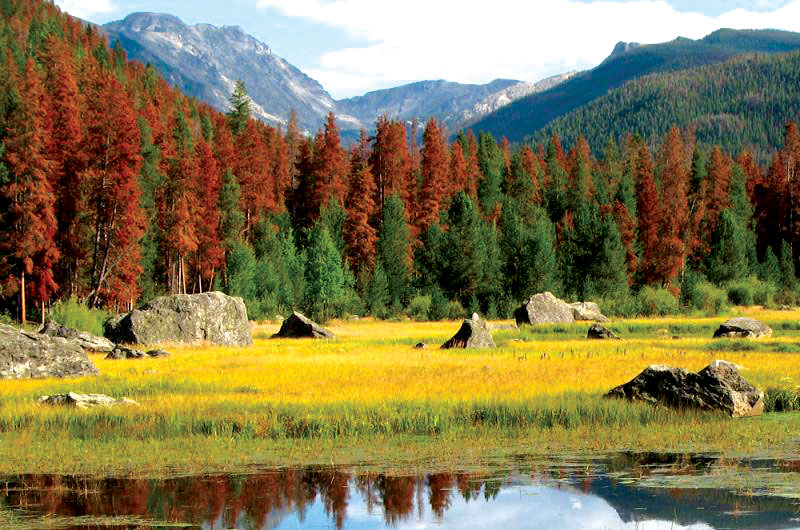
Our forests are dying. The situation seems epidemic—with impacts to our economy and our landscape. What caused it, and can we fix it?
About a seventh of our forests have lost many of their pines, spruces, and firs in the past decade.
Infestation by bark beetles is the primary mechanism of tree death. These native insects have been burrowing under tree bark for millions of years, usually targeting trees that are already stressed. Attacking beetles bore through the bark, girdling the tree, then make tunnels and chambers in which the eggs are laid. Both the adults and, later, legions of newly hatched beetle larvae, chow down on the soft living inner tissue of the tree. To add to the mix, beetles also carry fungi whose spores sap the tree of nutrients and water, and taint its wood blue-green.

A photo taken outside of Granby, Colorado shows the alarming number of reddish trees that have died due to beetle kill. Photo by Carlye Calvin, provided via Creative Commons license by UCAR photo library
Trees can be colonized within a matter of hours and infestations can kill a healthy tree within a few months. Normally, trees fight off beetles by producing toxic sap that poisons or entombs the invaders. But since the late 1990s, the sheer numbers of beetles—combined with the fact that many trees are stressed or weakened—are overwhelming forests.
The cause of this change? Fundamentally, it might be us.
Colorado’s warmer winters, earlier springs, and prolonged drought (like the one that began in the mid-90s) are now thought to be accentuated by global warming. Our warmer, shorter winters mean that beetle eggs don’t get frozen in the late fall, that larvae can survive the winter, and that ever-increasing numbers of beetles can emerge to colonize the next trees in the summer. Drought inhibits trees’ ability to produce beetle-fighting sap and healthy bark. In some places, decades of fire suppression have led to overcrowded, less patchy forests with trees of a similar age. All these factors make things easier for beetles to reproduce, feed, and survive, harder for trees to fight them off, and easier for infestations to spread through forests.
Other than ugly brown mountainsides, how do insect epidemics affect ecosystems and people? Like rebooting a computer, widespread tree mortality can throw the ecosystem out of whack for a while. It changes patterns of regrowth and habitat for wildlife. In nearby states, for example, it impacts grizzlies whose diets hinge on abundant pine cones. Fewer pine cones makes the bears hunger for other stuff. I don’t know about you, but I don’t want to be around a hungry grizzly.
Millions of dead trees have safety impacts, too. Within as little as three to 10 years, beetle-killed trees decay enough that they’re easily toppled by wind and other disturbances. They form piles of fuel that may alter fire hazard if lightning strikes. Thus they’re being removed where they might fall in campgrounds, along roads, utility paths, and near buildings.
But it isn’t all bad. Beetle boring activities provide habitat for other animals and fungi that help redistribute nutrients throughout a forest. Thus, despite their drastic effects during epidemics, beetles are a vital part of a healthy forest. Their comings and goings lead to forests having canopies of a variety of ages, different densities, and a variety of undergrowth like shrubs, grasses, and wildflowers. This variety makes for a more resilient forest long-term.
The forest death might have beneficial impacts for local businesses too. It provides cheap wood to our under-capacity sawmills and pellet mills, like those in Montrose and Walden. Ditto for our log-home industry, which prefers to use spruce trees, whose trunks are now available en masse. It’s even providing fuel to the state’s one wood-to-energy plant in Gypsum.
But only a tiny fraction of beetle kill wood is harvested—less than 5-10 percent. In part, this is because of the logistics and regulations governing gathering the wood and in part it’s because of the cost of cutting the wood versus its sale price. Thus, government agencies hire contractors to cut down most of the dead trees, and ultimately taxpayers foot the bill. Wood is either chipped and left to decompose on-site, or burned on-site in winter.
What can we do about it? Short of spraying trees one-by-one, by hand, with carbaryl every single year, like the folks in Rocky Mountain National Park are doing, there isn’t really a solution. We can manage the situation and plan for the future, removing hazardous trees where appropriate, and managing uninfested stands with an eye to fostering growth of more diverse and resilient forests.
Our forests have been hammered. But they’re resilient and will recover over the next 100–200 years.
In the meantime, if we don’t like the brown Rocky Mountain slopes, perhaps we could take a page out of drought-stricken California’s book. Paint ’em green.
James Hagadorn, Ph.D., is a scientist at the Denver Museum of Nature & Science. Suggestions and comments are welcome at jwhagadorn@dmns.org.


0 Comments